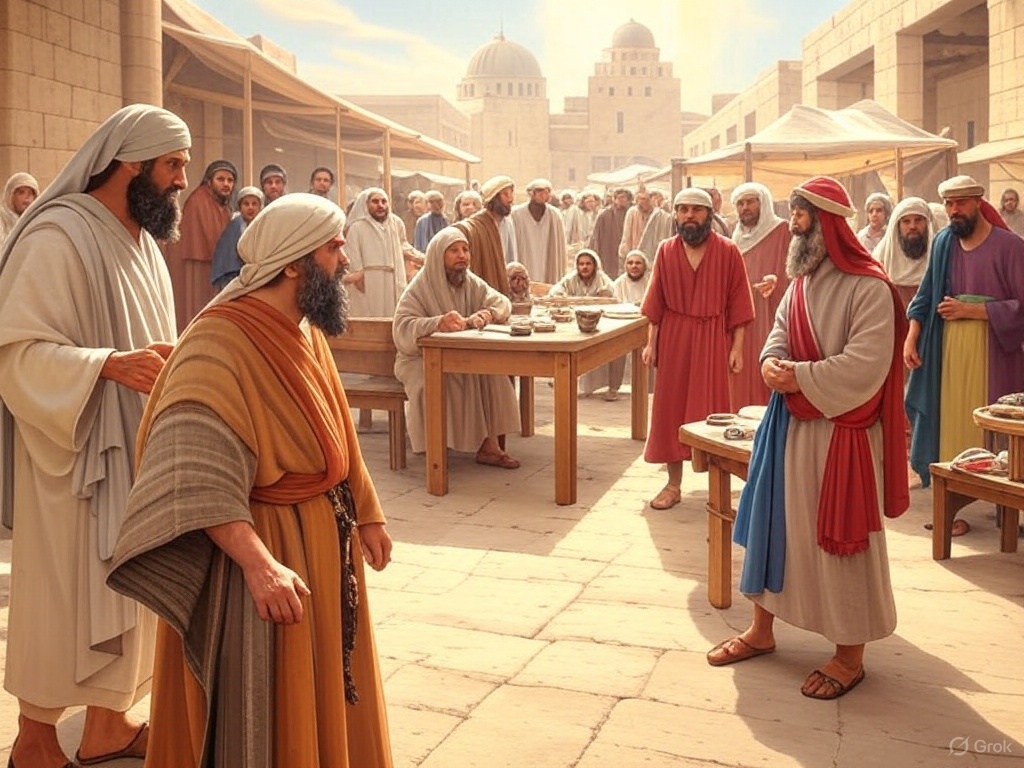The Jewish religious system during Jesus’ time (circa 4 BCE–30 CE) was a complex tapestry of institutions, sects, and roles, each shaping the spiritual, social, and political landscape of Judea under Roman rule. From synagogues to the Sanhedrin, Pharisees to Zealots, this period—known as the Second Temple era—offers a fascinating glimpse into the world Jesus navigated. In this blog, we’ll explore the key components of this system, including who they were, their origins, beliefs, and roles. This guide answers common questions like “What were the Jewish sects during Jesus’ time?” and “How did the religious system work in ancient Judea?”
Synagogues: The Heart of Local Worship
- What Were Synagogues? Known as “meeting places,” synagogues emerged during the Babylonian Exile (587–536 BCE) when the First Temple was destroyed, and Jews needed a new way to gather for prayer and study without a central sanctuary.
- Origins: Post-exilic necessity birthed synagogues as the Temple was no longer accessible. By Jesus’ time, they were widespread across Judea and other areas where Jews were living.
- Formation: Any area with 10 or more Jewish men could establish a synagogue, making it a grassroots institution.
- Jesus and Synagogues: In Luke 4:16-21 (NKJV), Jesus famously declared Himself the Messiah in a Nazareth synagogue, reading Isaiah 61:1-2: “The Spirit of the Lord is upon Me… Today this Scripture is fulfilled in your hearing.” This underscores the synagogue’s role as a teaching and communal hub.
Pharisees: The “Separated Ones” of Legalistic Zeal
- Origins: Emerging in the Intertestamental Period (circa 134–104 BCE), the Pharisees may have evolved from the Hasideans (“pious ones”), a group resisting Hellenistic influence after the Maccabean Revolt (167 BCE).
- Purpose: Initially noble, they aimed to preserve Jewish identity against Greek culture, earning the name “Pharisees” (from Hebrew perushim, meaning “separated ones”) for their strict adherence to the Torah and prophetic teachings.
- Evolution: By Jesus’ time, their focus shifted to oral traditions—interpretations they deemed as authoritative as the written Law. This led to legalism and self-righteousness, often criticized by Jesus (e.g., Matthew 23:23-24 NKJV).
- Social Role: Mostly laymen from the middle class (businessmen, tradesmen), not priests, they taught in synagogues, not the Temple. They held an arrogant stance toward non-Pharisees.
- Modern Meaning: Today, “Pharisee” describes someone prioritizing rules over spirit, self-righteousness, or perfectionism.
Sadducees: The Elite Temple Guardians
- Origins: Like the Pharisees, the Sadducees arose in the Intertestamental Period, though their exact roots are unclear. They likely stemmed from priestly aristocracy.
- Characteristics: Wealthy and politically savvy, they dominated the Temple priesthood, with high priests and chief priests typically Sadducees. Their focus was Temple-centric, rarely engaging in synagogues.
- Beliefs: They accepted only the Torah (Pentateuch), rejecting the Prophets, oral traditions, angels, and bodily resurrection—contrasting sharply with the Pharisees.
- Membership: Hereditary, not evangelistic, they cared little for Jewish purity compared to national stability under Rome.
- Popularity: Far less popular than the Pharisees among the masses.
Essenes: The Ascetic Outsiders
- Origins: Not mentioned in the Bible but documented in the Dead Sea Scrolls and by historians like Josephus and Philo, the Essenes likely formed around the 2nd century BCE, possibly as a priestly splinter group rejecting Temple corruption.
- Lifestyle: More legalistic than Pharisees, they lived in remote wilderness communities like Qumran, shunning society. They practiced celibacy (though some married), shared property, avoided commerce and war, and followed a strict code.
- Beliefs: Apocalyptic and dualistic, they saw themselves as “Sons of Light” against “Sons of Darkness,” expecting two messiahs (priestly and kingly). They emphasized purity and predestination.
- Legacy: The Dead Sea Scrolls, linked to Qumran, preserve their writings and the oldest Hebrew Scriptures.
Zealots: The Fiery Nationalists
- Origins: Emerging during Roman occupation (post-63 BCE), the Zealots shared the Pharisees’ zeal for the Law but channeled it into violent nationalism.
- Beliefs and Actions: They opposed Roman rule fiercely, refusing taxes to a pagan emperor. Their rebellions escalated Jewish-Roman tensions.
- Impact: Their fervor, alongside broader nationalism, contributed to Jerusalem’s destruction in 70 CE by Roman forces under Titus.
Scribes: The Legal Scholars
- Origins: Known since Old Testament times (e.g., Ezra in Ezra 7:6), scribes initially recorded transactions and read documents as secretaries.
- Role in Jesus’ Time: Called “lawyers” or “teachers of the law,” they were a professional class, not a religious or political sect. They aligned more with Pharisees but served Sadducees too.
- Status: Highly respected, they transitioned from priestly roles to a distinct group by the 1st century CE.
The Sanhedrin: The Jewish Council
- What Was It? From the Greek sunedrion (“sitting together”), the Sanhedrin was a judicial and religious council system.
- Structure:
- Lesser Sanhedrin: Local courts with 7 members (small towns) or 23 (larger cities), tied to synagogues, handling civil and religious matters.
- Great Sanhedrin: The supreme court in Jerusalem, with 71 (sometimes 70) members, centered at the Temple. It oversaw national religious, legal, and political issues.
- Limitations: Under Roman rule, the Sanhedrin could impose death sentences, but lacked authority to actually carry out death penalties. This was reserved for the Roman government alone (e.g., Jesus’ trial, John 18:31).
- Members: Included the high priest (head), scribes, elders (lay leaders), Levites, ordinary Jews of pure lineage, Sadducees, Pharisees, the Nasi (president), and Av Beit Din (vice-president).
Why This Matters Today
Understanding these groups—synagogues, Pharisees, Sadducees, Essenes, Zealots, scribes, and the Sanhedrin—illuminates the context of Jesus’ ministry and the New Testament. Each played a unique role in a society wrestling with Roman occupation, religious identity, and messianic hope. Their interactions with Jesus, from synagogue teachings to Sanhedrin trials, shaped early Christianity and Jewish history post-70 CE, when the Temple’s fall shifted worship to synagogues and Torah study.
Related Topics to Explore:
- How did the Temple’s destruction in 70 CE affect Judaism?
- What are the Dead Sea Scrolls, and why are they significant?
- How did Jesus challenge the religious leaders of His day?
This guide offers a detailed yet accessible overview, perfect for students, Bible readers, or history enthusiasts searching for clarity on the Jewish religious system during Jesus’ time.

